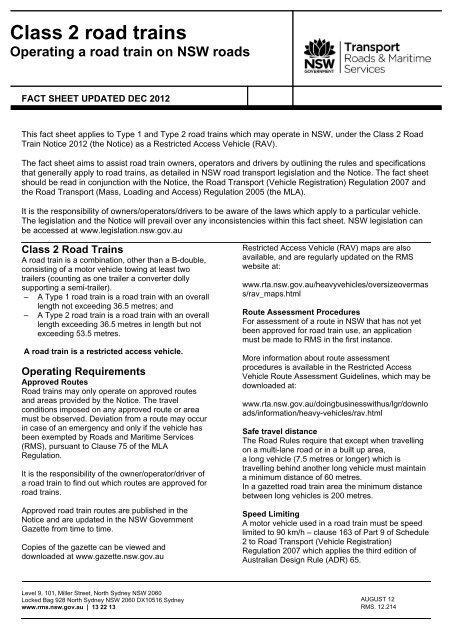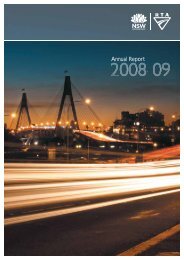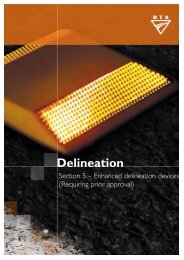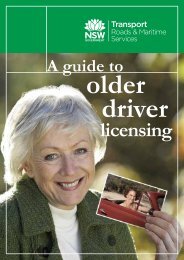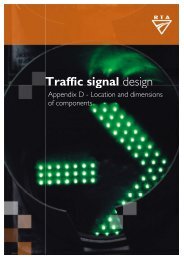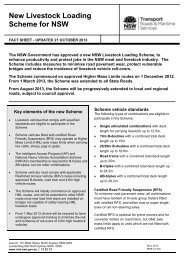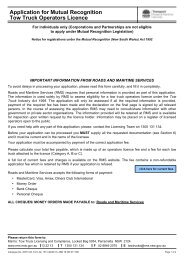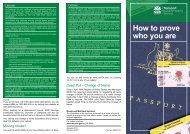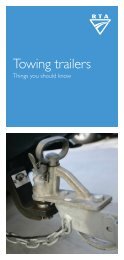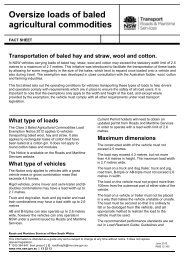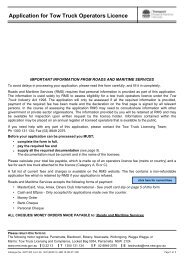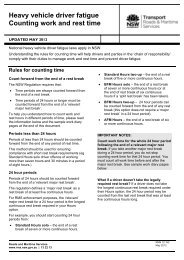Class 2 road trains fact sheet - RTA - NSW Government
Class 2 road trains fact sheet - RTA - NSW Government
Class 2 road trains fact sheet - RTA - NSW Government
Create successful ePaper yourself
Turn your PDF publications into a flip-book with our unique Google optimized e-Paper software.
<strong>Class</strong> 2 <strong>road</strong> <strong>trains</strong><br />
Operating a <strong>road</strong> train on <strong>NSW</strong> <strong>road</strong>s<br />
FACT SHEET UPDATED DEC 2012<br />
This <strong>fact</strong> <strong>sheet</strong> applies to Type 1 and Type 2 <strong>road</strong> <strong>trains</strong> which may operate in <strong>NSW</strong>, under the <strong>Class</strong> 2 Road<br />
Train Notice 2012 (the Notice) as a Restricted Access Vehicle (RAV).<br />
The <strong>fact</strong> <strong>sheet</strong> aims to assist <strong>road</strong> train owners, operators and drivers by outlining the rules and specifications<br />
that generally apply to <strong>road</strong> <strong>trains</strong>, as detailed in <strong>NSW</strong> <strong>road</strong> transport legislation and the Notice. The <strong>fact</strong> <strong>sheet</strong><br />
should be read in conjunction with the Notice, the Road Transport (Vehicle Registration) Regulation 2007 and<br />
the Road Transport (Mass, Loading and Access) Regulation 2005 (the MLA).<br />
It is the responsibility of owners/operators/drivers to be aware of the laws which apply to a particular vehicle.<br />
The legislation and the Notice will prevail over any inconsistencies within this <strong>fact</strong> <strong>sheet</strong>. <strong>NSW</strong> legislation can<br />
be accessed at www.legislation.nsw.gov.au<br />
<strong>Class</strong> 2 Road Trains<br />
A <strong>road</strong> train is a combination, other than a B-double,<br />
consisting of a motor vehicle towing at least two<br />
trailers (counting as one trailer a converter dolly<br />
supporting a semi-trailer).<br />
– A Type 1 <strong>road</strong> train is a <strong>road</strong> train with an overall<br />
length not exceeding 36.5 metres; and<br />
– A Type 2 <strong>road</strong> train is a <strong>road</strong> train with an overall<br />
length exceeding 36.5 metres in length but not<br />
exceeding 53.5 metres.<br />
A <strong>road</strong> train is a restricted access vehicle.<br />
Operating Requirements<br />
Approved Routes<br />
Road <strong>trains</strong> may only operate on approved routes<br />
and areas provided by the Notice. The travel<br />
conditions imposed on any approved route or area<br />
must be observed. Deviation from a route may occur<br />
in case of an emergency and only if the vehicle has<br />
been exempted by Roads and Maritime Services<br />
(RMS), pursuant to Clause 75 of the MLA<br />
Regulation.<br />
It is the responsibility of the owner/operator/driver of<br />
a <strong>road</strong> train to find out which routes are approved for<br />
<strong>road</strong> <strong>trains</strong>.<br />
Approved <strong>road</strong> train routes are published in the<br />
Notice and are updated in the <strong>NSW</strong> <strong>Government</strong><br />
Gazette from time to time.<br />
Copies of the gazette can be viewed and<br />
downloaded at www.gazette.nsw.gov.au<br />
Restricted Access Vehicle (RAV) maps are also<br />
available, and are regularly updated on the RMS<br />
website at:<br />
www.rta.nsw.gov.au/heavyvehicles/oversizeovermas<br />
s/rav_maps.html<br />
Route Assessment Procedures<br />
For assessment of a route in <strong>NSW</strong> that has not yet<br />
been approved for <strong>road</strong> train use, an application<br />
must be made to RMS in the first instance.<br />
More information about route assessment<br />
procedures is available in the Restricted Access<br />
Vehicle Route Assessment Guidelines, which may be<br />
downloaded at:<br />
www.rta.nsw.gov.au/doingbusinesswithus/lgr/downlo<br />
ads/information/heavy-vehicles/rav.html<br />
Safe travel distance<br />
The Road Rules require that except when travelling<br />
on a multi-lane <strong>road</strong> or in a built up area,<br />
a long vehicle (7.5 metres or longer) which is<br />
travelling behind another long vehicle must maintain<br />
a minimum distance of 60 metres.<br />
In a gazetted <strong>road</strong> train area the minimum distance<br />
between long vehicles is 200 metres.<br />
Speed Limiting<br />
A motor vehicle used in a <strong>road</strong> train must be speed<br />
limited to 90 km/h – clause 163 of Part 9 of Schedule<br />
2 to Road Transport (Vehicle Registration)<br />
Regulation 2007 which applies the third edition of<br />
Australian Design Rule (ADR) 65.<br />
Level 9, 101, Miller Street, North Sydney <strong>NSW</strong> 2060<br />
Locked Bag 928 North Sydney <strong>NSW</strong> 2060 DX10516 Sydney<br />
www.rms.nsw.gov.au | 13 22 13<br />
AUGUST 12<br />
RMS. 12.214
Tracking Requirements<br />
When travelling in a straight line on a level, smooth<br />
surface, all units in a <strong>road</strong> train must track in the path<br />
of the prime mover without shifting or swerving more<br />
than 100 millimetres either side of the prime mover.<br />
Diagram 1: Measuring Drawbar Length<br />
Warning Signs<br />
A <strong>road</strong> train that is more than 30 metres long must be<br />
fitted with a horizontal “Road Train” warning sign to<br />
both the front and rear of the combination.<br />
A <strong>road</strong> train that is more than 22 metres but less than<br />
30 metres must be fitted with either a:<br />
– “Road Train” warning sign fitted horizontally to<br />
both the front and rear of the combination; or<br />
– a “Long Vehicle” warning sign fitted horizontally<br />
to the rear of the combination.<br />
Mass & Dimension Limits<br />
Maximum Overall dimension limits<br />
A Type 1 <strong>road</strong> train must not be more than 36.5<br />
metres long or more than 2.5 metres wide.<br />
A Type 2 <strong>road</strong> train is longer than 36.5 metres in<br />
length but must not be more than 53.5 metres and<br />
not wider than 2.5 metres.<br />
A <strong>road</strong> train must not be more than 4.3 metres high.<br />
However, a <strong>road</strong> train may be higher than 4.3<br />
metres, but not more than 4.6 metres high, subject to<br />
compliance with the conditions set out in the current<br />
4.6 Metre High Vehicle Route Notice, as well as the<br />
current <strong>Class</strong> 2 Road Train Notice.<br />
Cautionary note: The maximum overall length of<br />
a prime mover and semi trailer combination is 19<br />
metres. When a <strong>road</strong> train is reconfigured to<br />
become a prime mover and semi trailer<br />
combination it is the operator’s responsibility to<br />
ensure that the legal overall dimension limit of<br />
the reconfigured combination is met.<br />
Maximum Drawbar Length<br />
The distance between the coupling pivot point on the<br />
drawbar and the centre line of the axle (for single<br />
axle) or axle group of a converter dolly, must:<br />
– Not be over 5 metres; and<br />
– Not be under 3 metres if used in a <strong>road</strong> train<br />
over 19 metres long:<br />
The length of a drawbar is measured as shown in<br />
Diagram 1, in the case of a:<br />
– Single axle converter dolly; from the coupling<br />
pivot point to the centre line of the axle of the<br />
converter dolly – X.<br />
– Tandem axle converter dolly; from the coupling<br />
pivot point to the centre line of the tandem axle<br />
converter dolly – Y.<br />
– Tri-axle converter dolly; from the coupling pivot<br />
point to the centre line of the second axle of the<br />
converter dolly – Z.<br />
Drawbar Height<br />
A drawbar-type coupling, or drawbar eye, used in a<br />
<strong>road</strong> train must be built and positioned so that it is at<br />
a height of at least 800 millimetres, but not over 950<br />
millimetres, when the <strong>road</strong> train is unloaded and<br />
parked on level ground.<br />
A drawbar coupling may be exempt from the above<br />
height dimension requirements if the drawbar<br />
coupling is designed such that it permits the drawbar<br />
eye, when coupled to have the following degree/s of<br />
articulation:<br />
– ±90° horizontally about the vertical axis from the<br />
longitudinal axis of the vehicle; and<br />
– ±20° vertically about the transverse axis from<br />
the horizontal plane of the vehicle; and<br />
– ±25° axial rotation about the longitudinal axis<br />
from the horizontal plane of the vehicle.<br />
The above measurements must be verified and<br />
approved by a Vehicle Safety Compliance<br />
Certification Scheme (VSCCS) Licensed Certifier and<br />
evidence of verification must be carried in the vehicle<br />
and produced when requested by a police officer or<br />
an authorised person.<br />
Maximum General Mass Limits (GML) for axles<br />
and axle groups<br />
– The maximum axle mass limits for a <strong>road</strong> train<br />
must be the lowest of:<br />
– The manu<strong>fact</strong>urers’ mass ratings; or<br />
– The sum of the mass limits for the tyres fitted to<br />
the axles and axle groups in Table A.<br />
Table A: Axle and Axle Group Mass Limits<br />
Steering single axle<br />
6.0 tonnes gross*<br />
Single axle consisting of 4<br />
tyres<br />
Tandem axle group<br />
consisting of 8 tyres<br />
Tri-axle group consisting of<br />
12 tyres<br />
Tri-axle group consisting of 6<br />
tyres with section widths at<br />
least 375 milimetres<br />
9.0 tonnes gross<br />
16.5 tonnes<br />
20.0 tonnes<br />
20.0 tonnes<br />
*6.5 tonnes is permitted on the steer axle if the vehicle complies<br />
with the <strong>Class</strong> 3 Single Steer Axle Mass Limit Exemption Notice<br />
2010.<br />
RMS CLASS 2 ROAD TRAIN FACT SHEET 2
Maximum GML Total Combination Mass Limits<br />
Under the Notice different GML total combination<br />
mass limits will apply depending upon the type of<br />
<strong>road</strong> train and whether the <strong>road</strong> train is or is not fitted<br />
with a tri-axle dolly which is equipped with certified<br />
Road Friendly Suspension (RFS # ). The following<br />
total combination mass limits apply:<br />
Type 1 Road Train – no certified RFS#<br />
The following total combination mass limits apply to a<br />
Type 1 <strong>road</strong> train fitted with a converter dolly which is<br />
not equipped with certified RFS. The maximum<br />
permissible total combination mass is the lowest of:<br />
• 79.0 tonnes; or<br />
• The sum of the axle and axle group mass<br />
limits as determined by Table 1, Clause 2,<br />
Schedule 1 to the MLA Regulation; or<br />
• The sum of the manu<strong>fact</strong>urers’ mass limits<br />
for the prime mover (GVM) and the semitrailers;<br />
or<br />
• The gross combination mass (GCM) limit<br />
specified by the prime mover manu<strong>fact</strong>urer.<br />
Type 2 Road Train – no certified RFS#<br />
The following total combination mass limits apply to a<br />
Type 2 <strong>road</strong> train fitted with two converter dollies<br />
which are not equipped with certified RFS. The<br />
maximum permissible total combination mass is the<br />
lowest of:<br />
115.5 tonnes; or<br />
The sum of the axle and axle group mass limits as<br />
determined by Table 1, Clause 2, Schedule 1 to the<br />
MLA Regulation; or<br />
• The sum of the manu<strong>fact</strong>urers’ mass limits<br />
for the prime mover (GVM) and the semitrailers;<br />
or<br />
• The gross combination mass (GCM) limit<br />
specified by the prime mover manu<strong>fact</strong>urer.<br />
Type 1 Road Train – equipped with certified RFS #<br />
The following total combination mass limits apply to a<br />
Type 1 <strong>road</strong> train fitted with one tri-axle converter<br />
dolly which is equipped with certified RFS. The<br />
maximum permissible total combination mass is the<br />
lowest of:<br />
• 82.5 tonnes; or<br />
• The sum of the axle and axle group mass<br />
limits as determined by Table 1, Clause 2,<br />
Schedule 1 to the MLA Regulation; or<br />
• The sum of the manu<strong>fact</strong>urers’ mass limits<br />
for the prime mover (GVM) and the semitrailers;<br />
or<br />
• The gross combination mass (GCM) limit<br />
specified by the prime mover manu<strong>fact</strong>urer.<br />
Type 2 Road Train – equipped with certified RFS #<br />
The following total combination mass limits apply to a<br />
Type 2 <strong>road</strong> train fitted with two tri-axle converter<br />
dollies both of which are equipped with certified RFS.<br />
The maximum permissible total combination mass is<br />
the lowest of:<br />
• 122.5 tonnes; or<br />
• The sum of the axle and axle group mass<br />
limits as determined by Table 1, Clause 2,<br />
Schedule 1 to the MLA Regulation; or<br />
• The sum of the manu<strong>fact</strong>urers’ mass limits<br />
for the prime mover (GVM) and the semitrailers;<br />
or<br />
• The gross combination mass (GCM) limit<br />
specified by the prime mover manu<strong>fact</strong>urer.<br />
Type 2 Road Train – equipped with certified RFS #<br />
on one tri-axle group only<br />
The following total combination mass limits apply to a<br />
Type 2 <strong>road</strong> train fitted with two tri-axle converter<br />
dollies one of which is a tri-axle converter dolly which<br />
is equipped with certified RFS and one is a converter<br />
dolly (whether one, two or three axles) which is not<br />
equipped with certified RFS, The maximum<br />
permissible total combination mass is the lowest of:<br />
• 119.0 tonnes; or<br />
• The sum of the axle and axle group mass<br />
limits as determined by Table 1, Clause 2,<br />
Schedule 1 to the MLA Regulation; or<br />
• The sum of the manu<strong>fact</strong>urers’ mass limits<br />
for the prime mover (GVM) and the semitrailers;<br />
or<br />
• The gross combination mass (GCM) limit<br />
specified by the prime mover manu<strong>fact</strong>urer.<br />
Requirements for a <strong>road</strong> train that is fitted with<br />
certified RFS # tri-axle converter dollies<br />
Operators must ensure that they carry evidence<br />
verifying that each tri-axle converter dolly is fitted<br />
with certified RFS # . The evidence must be produced<br />
when requested by a police officer or an authorised<br />
person.<br />
The following evidence can be produced:<br />
– A manu<strong>fact</strong>urer’s decal, label or plate affixed to,<br />
or near, the suspension system indicating the<br />
RFS Certificate Number; or<br />
– A certificate or signed letter from the<br />
manu<strong>fact</strong>urer identifying the <strong>road</strong> friendly<br />
suspension make and model; or<br />
– Any other documentation approved by<br />
Roads and Maritime Services (RMS).<br />
Axle spacing requirements<br />
A Type 1 <strong>road</strong> train must comply with the adjacent<br />
axle groups spacing requirements calculated in<br />
accordance with the formula*:<br />
M = 3L + 12.5 where:<br />
M is the mass limit in tonnes.<br />
L is the distance in metres.<br />
In addition a type 1 <strong>road</strong> train must maintain a<br />
spacing between the outermost axles of not less<br />
than 26.5 metres. (see Figure: 1 on page 4)<br />
RMS CLASS 2 ROAD TRAIN FACT SHEET 3
A Type 2 <strong>road</strong> train must comply with the axle<br />
spacing requirements calculated in accordance with<br />
the formula*:<br />
M = 3L + 12.5 where:<br />
M is the mass limit in tonnes.<br />
L is the distance in metres.<br />
Cautionary note: Where a Type 2 <strong>road</strong> train is<br />
reconfigured to become a Type 1 <strong>road</strong> train,<br />
different axle spacing requirements may apply. It<br />
is the operator’s responsibility to ensure that the<br />
different requirements are met when there has<br />
been a change in the vehicle configuration.<br />
Concessional Mass Limits<br />
Type 1 and Type 2 <strong>road</strong> <strong>trains</strong> are eligible for<br />
operation at Concessional Mass Limits (CML)<br />
provided they comply with the requirements of the<br />
current <strong>Class</strong> 3 Concessional Mass Limits Notice.<br />
Higher Mass Limits<br />
Type 1 <strong>road</strong> <strong>trains</strong> are eligible for operation at Higher<br />
Mass Limits (HML) provided they are enrolled into<br />
the Intelligent Access Program (IAP) and meet all<br />
operating requirements. Further information on HML<br />
including conditions and eligibility requirements can<br />
be found at:<br />
www.rta.nsw.gov.au/heavyvehicles/iap/hml.html<br />
Type 2 <strong>road</strong> <strong>trains</strong> are not eligible for HML.<br />
Cautionary note: Road train vehicles loaded to<br />
the maximum tri-axle dolly mass limits (i.e. 20<br />
tonnes GML, 21 tonnes CML and 22.5 tonnes<br />
HML) will be unable to de-couple the rear trailer<br />
and use it to operate in a semi-trailer<br />
combination while complying with mass limits.<br />
This is because the load on the tri-axle dolly (i.e.,<br />
20 tonnes GML, 21 tonnes CML, and 22.5 tonnes<br />
HML) is in excess of the capacity of the tandem<br />
drive axle group of the prime mover (16.5 tonnes<br />
GML, 17 tonnes CML/HML). It is the Transport<br />
Operator’s responsibility when de-coupling to<br />
ensure compliance with mass limits.<br />
Figure 1 – Axle Spacing Requirements<br />
Note: The outermost axle spacing is measured from the centre line of the steer axle on the prime mover to the centre<br />
line of the last axle in the combination as illustrated in Figure 1.<br />
Special Note: Where a tri-axle converter dolly without certified RFS is used in a <strong>road</strong> train combination - that tri-axle dolly<br />
may carry up to 20 tonnes, subject to the combination complying with the total combination mass limit specified in Table<br />
B.(see page 5)<br />
# Road Friendly Suspension (RFS) can be either airbag or mechanical/spring suspension systems. A suspension system<br />
can only be considered “certified” if it has been certified by the Commonwealth Department of Infrastructure and<br />
Transport as being RFS. Further information on the certification process can be found using the following link<br />
http://www.infrastructure.gov.au/<strong>road</strong>s/vehicle_regulation/bulletin/<br />
*Note this formula does not apply to the non adjacent or extreme axle groups for the <strong>road</strong> train combination<br />
~The Total Combination Mass Limit is increased by 0.5 tonne for vehicles that comply with the conditions set out in the<br />
<strong>Class</strong> 3 Single Steer Axle Mass Limit Exemption Notice 2010.<br />
To access heavy vehicle notices, including the <strong>Class</strong> 2 Road Train Notice 2012, and further information about heavy<br />
vehicle licensing and registration please visit www.rms.nsw.gov.au/heavyvehicles<br />
RMS CLASS 2 ROAD TRAIN FACT SHEET 4
Table B:Summary of Mass Limits by Combination<br />
Type 1 Road Train with Tandem Axle Dolly<br />
Type 1 Road Train with Tri-axle Dolly NOT fitted with RFS #<br />
Type 1 Road Train with Tri-axle Dolly fitted with RFS #<br />
Type 2 Road Train with two Tandem Axle Dollies<br />
GML: 79.0t~<br />
CML: 81.0t~<br />
HML: 85.0t~<br />
GML: 79.0t~<br />
CML: 81.0t~<br />
Not Eligible for HML<br />
GML: 82.5t~<br />
CML: 84.5t~<br />
HML: 90.5t~<br />
GML: 115.5t~<br />
CML: 117.5t~<br />
Not Eligible for HML<br />
Type 2 Road Train with one Tandem axle Dolly and one Tri-axle Dolly NOT fitted with RFS #<br />
GML:115.5t~<br />
CML 117.5t~<br />
Not Eligible for HML<br />
Type 2 Road Train with Two Tri-axle Dollies NOT fitted with RFS #<br />
GML:115.5t~<br />
CML 117.5t~<br />
Not Eligible for HML<br />
Type 2 Road Train with one Tandem axle Dolly and one Tri-axle Dolly fitted with RFS #<br />
GML:119.0t~<br />
CML 121.0~<br />
Not Eligible for HML<br />
Type 2 Road Train with one Tri-axle Dolly NOT fitted with RFS # and one Tri-axle Dolly fitted<br />
with RFS #<br />
GML: 119.0t~<br />
Type 2 Road Train with two Tri-axle Dollies fitted with RFS #<br />
For more information please call 13 22 13.<br />
CML: 121.0t~<br />
Not Eligible for HML<br />
GML: 122.5t~<br />
CML: 124.5t~<br />
Not Eligible for HML<br />
RMS CLASS 2 ROAD TRAIN FACT SHEET 5


